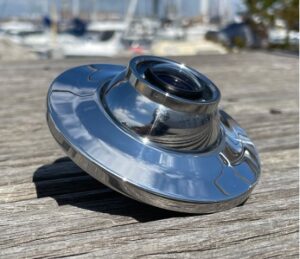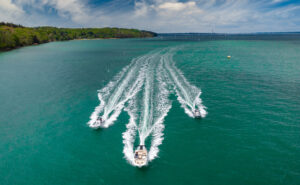Will emission-free cruise ships pave the way for the recreational boat industry?

Regional transition to electric propulsion is no simple feat, but in Norway new government regulations will make zero-emissions mandatory in the UNESCO World Heritage sites of Geirangerfjord and Nærøyfjord from 2026. As a result, the only vessels allowed to operate in these fjords will have to be emission-free.
It might be assumed that ferry operators would be left scrambling to meet this deadline, yet two of the three local sightseeing ferries already have 100 per cent electric propulsion, while their older sistership (launched in 2016) has a hybrid diesel/electric system. The ferries, which each take 400 passengers, are run by travel company The Fjords and are built of carbon fibre and powered by twin 450kW motors, giving cruising speeds of 16 knots.
While zero tailpipe emissions can come at the cost of some carbon emissions and noxious pollutants at power stations elsewhere, Norway generates 98 per cent of its electricity through hydro or wind power.
One obstacle in the Norwegian programme, however, was that the local grid could not directly support the charging needs of the boats while in port. Instead of increasing onboard battery capacity, which would unnecessarily increase the vessels’ displacement, The Fjords installed a floating recharge dock with a 2,400MWh battery capacity, which could be charged during periods of low local demand each day and recharge the ferries during their 20-minute turnarounds. A useful spin-off is that the recharger also has potential for local use, for instance to charge electric vehicles without needing to increase the capacity of the local grid, thus further smoothing peaks and troughs in electrical demand.
The region’s cruise ships are also readying for a zero-emission future. Oslo-based Northern Xplorer (NX), a company founded by Rolf André Sandvik who also founded The Fjords, has released plans for a zero-emission 130-metre cruise ship that will rely on a combination of mains power when in port, and hydrogen and electric power when underway. The company also wants to explore solar and wind power possibilities.
Read more industry insights in Marine Industry News print edition Issue 4.
“NX sets a new course for sustainable cruising for thinking travellers, with future expansion providing a gateway to other European destinations both coastal and on navigable waterways inland,” says founder and CEO Sandvik.
Sandvik says he wants to “walk the talk” on green maritime innovation.
The current plan is for a series of 14 NX ships accommodating up to 250 passengers, with the first due to be operational in 2025/2026.
UNESCO sites and far-flung islands aren’t the only parts of the world that need protection from pollutants associated with internal combustion engines. Concerns about the detrimental effects of exhaust emissions on health mean that city administrations across the UK and Europe are rapidly adopting stringent controls on vehicles with internal combustions engines.
In many cities, the phase-out of vehicles with traditional internal combustion engines is happening at a much faster pace than changes proposed by central governments. Buses running on petrol or diesel, for example, are already banned from central Amsterdam and in 2025 this zone will be expanded to the whole area inside the A10 ring road, which passes just outside the Amsterdam RAI, home of METSTRADE.
The extended Amsterdam ban will also apply to the many ferries and tour boats operating on the city’s waterways. That might appear to be another tall order to achieve, but conversion work is already well underway on existing boats in Amsterdam.
In Berlin, Berliner Wassertaxi is preparing for a more environmentally friendly future and has converted its 20-metre, 55-passenger sightseeing boat and water taxi from diesel power to a fully integrated all-electric propulsion system by Torqeedo. The sightseeing boat is the city’s first retrofit electric tourist boat and has a Deep Blue 50i electric drive, plus three Deep Blue batteries with 120 kWh capacity.
In fact, cities have been showing the industry the way for many years; electric water buses, for example, have been ferrying passengers across the canals at La Rochelle and Les Sables d’Olonne on the Atlantic coast of France for more than a decade. Both routes use lightweight catamarans with extensive solar arrays to minimise the power from the grid.
We have a tendency to assume that sustainable options are automatically more expensive than conventional craft, however, that’s not universally the case once full lifecycle costs are factored in.
In New Zealand, East by West Ferries has launched the country’s first fully electric, zero-emission passenger ferry. The Ike Rere is a 132-passenger all-electric ferry with lifetime costs projected to be 35 per cent less than a diesel-powered aluminium boat over a 20-year lifespan. Key factors in this saving include a predicted 60 per cent reduction in propulsion energy costs, plus electric motors rated for 50,000 hours of maintenance-free operation.
Designed by SSC Marine, the Ike Rere will operate on a 25km route across Wellington harbour at a service speed of 20 knots and carries a third more passengers than existing craft. It was built by WebbCo of lightweight carbon fibre, with structural engineering by Gurit and is powered by Danfoss’ compact Editron marine drivetrain. “Our two other diesel ferries use about 250,000 litres of fuel a year between them,” says East by West managing director Jeremy Ward.
“It’s not sustainable for the planet and I knew electrification was the answer. I was surprised to discover we were the first in New Zealand to be doing it.”
Erno Tenhunen, marine director of Danfoss Power Solutions’ Editron division, says: “Shipowners are now choosing to implement electrical solutions on board because of the conjunction between technological advances and the availability and cost of renewable energy. Batteries are becoming more compact and their price is falling, making electrified vessels more cost-effective and appealing to owners.”
In many respects what may be regarded as futuristic technology is already proven to work. What is needed is larger regulators to take the lead on setting emission targets. As seen in Norway, if a strong stance is taken then a ripple effect will be felt throughout the industry with tech advances and uptake likely to follow.










